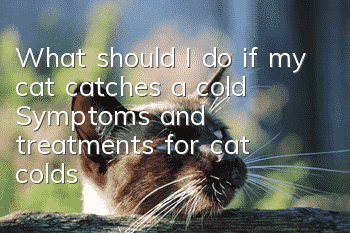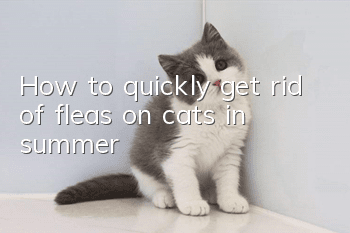What should I do if my cat catches a cold? Symptoms and treatments for cat colds

Cats can also catch colds. If you don’t pay attention to care, the acute febrile disease caused by cat upper respiratory tract catarrh is cat cold. Cat colds are most common in kittens with poor immunity. If not treated in time, kittens may be life-threatening.
1. The cat’s physical fitness is poor, its resistance is weak, and the cattery’s cold-proof performance is poor.
2. When the temperature in nature drops suddenly and the temperature difference is too large, the resistance of the respiratory mucosa is often reduced. The cat's body is stimulated by the cold and cannot adapt to the changes for a while and develops a cold.
3. It is more common especially in early spring or late autumn when the temperature is changeable. Or it can also happen when a cat sweats during exercise and then is attacked by air conditioning.
Clinical symptoms of cat cold
1. Runny nose and loud breathing sound
Cats are like babies. They will feel it clearly after catching a cold. Because cats are relatively lazy animals and sleep more often. If they have difficulty breathing and make loud noises, they may have a cold.
2. Tears
After a cat catches a cold, it causes nasal congestion, and the nasolacrimal ducts are connected. If the nose is blocked, the only way out is from the tear duct, and tears will flow from there. This is normal, just like a cold in humans.
3. Sneezing
Sneezing is usually caused by an allergy in the nose or an itchy sensation that goes deep into the external canal and is released through involuntary eruptions. Sneezing is also a common symptom of a cold.
IV. Coughing or shivering
Generally, a cold will be accompanied by a cough, and severe cases will cause shivering, so don’t worry too much.
Principles of treatment for cat colds
1. Keep warm and take more care. Increase nutrition to improve the cat's own resistance until it recovers naturally. Cats with high body temperatures and not eating will need intravenous fluids.
2. Take the cat to the pet hospital and intramuscularly inject antipyretic and analgesic drugs such as 0.1ml of 5% Dipyridine or 0.5ml of compound aminopyrine solution.
3. To control upper respiratory tract inflammation, go to the hospital for intramuscular injection of antibiotics or sulfa drugs; or take oral cotrimoxazole, 15 to 30 mg/kg, twice a day. Be careful not to feed at human dosage.
- What precautions should be taken when bathing Persian cats?
- How to distinguish male and female newborn kittens
- How to judge the status of two cats
- How to wean a female cat and kittens together
- Will cats die if they eat chocolate?
- Can cats eat lychees?
- Is a cat like Garfield easy to raise?
- Blue cat postpartum nutrition supplement
- What is the disease of green cat urine?
- How to comfort a cat when he is depressed



